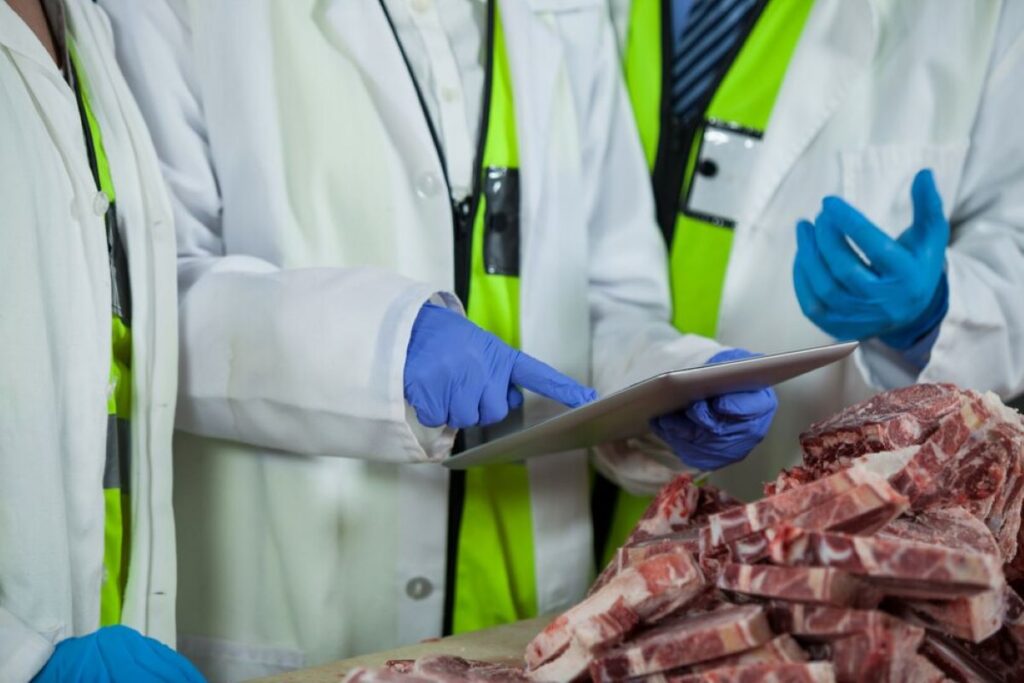Food safety compliance and risk management are crucial in today’s food industry. If safety measures are not taken seriously, the consequences can be severe – including foodborne illnesses, damage to reputation, significant financial losses, and legal issues.
To effectively manage food safety, businesses need to:
- Monitor critical control points systematically
- Document safety procedures in real-time
- Assess and mitigate risks proactively
- Comply with regulations in various regions
The food industry is under increasing pressure to uphold strict safety standards while also adapting to changing regulations. This means that modern businesses must have strong systems in place to track compliance, manage risks, and ensure consistent food safety practices throughout their operations.
Some key factors to consider when maintaining Food Safety Compliance and Risk Management standards include:
- Implementing automated monitoring systems
- Providing regular training for staff and assessing their competency
- Verifying suppliers through rigorous processes
- Managing documentation and ensuring traceability
- Integrating technology-driven solutions
By focusing on these areas, businesses can create a comprehensive framework that protects public health, meets regulatory requirements, and safeguards their operations in the food sector.
Comprehensive Compliance Solution: Squizify
Squizify is a powerful compliance solution designed specifically for the food industry’s complex regulations. This Software-as-a-Service (SaaS) platform offers a wide range of tools to ensure food safety and smooth operations.
Key Features:
- Customisable digital checklists
- Automated record-keeping systems
- Advanced auditing capabilities
- Temperature monitoring sensors
- Food label printing integration
- Freight temperature tracking
The platform’s intelligent design supports multiple industry sectors:
- Hospitality
- Healthcare facilities
- Aged care centres
- Childcare establishments
- Supermarket chains
- Fuel sites
- Manufacturing facilities
Operational Benefits:
- Real-time data accessibility through internet-connected devices
- Streamlined documentation processes
- Enhanced accuracy in compliance reporting
- Cost-effective regulatory adherence
- Time-saving automated workflows
Squizify’s secure infrastructure ensures 24/7 data availability while maintaining strict confidentiality standards. The platform’s customisation capabilities allow businesses to tailor the software to their specific operational requirements through dedicated discovery calls and demonstration sessions.
The system’s integrated approach combines hardware solutions with sophisticated software features, creating a unified ecosystem for food safety management. This integration enables businesses to maintain consistent compliance standards while optimising their operational efficiency.
Role of Food Safety Management Systems (FSMS) in Compliance Tracking and Risk Management
Food Safety Management Systems are crucial for food businesses to meet regulations and manage risks. These digital solutions replace old-fashioned manual methods with efficient, automated processes that improve food safety practices.
Key Functions of FSMS:
1. Automated Documentation Management
- Digital storage of critical safety records
- Real-time updates of compliance documentation
- Standardised templates for consistent reporting
2. Risk Identification and Assessment
- Systematic hazard analysis
- Critical control point monitoring
- Automated alerts for safety breaches
3. Prevention of Foodborne Illnesses
- Temperature monitoring and logging
- Hygiene compliance tracking
- Cross-contamination prevention protocols
FSMS platforms combine data from various sources to create a comprehensive safety net. The systems analyse patterns in real-time data, enabling quick identification of potential food safety risks before they escalate into serious issues.
These digital solutions improve traceability by keeping detailed records of food handling processes, supplier information, and safety checks. The automated documentation ensures compliance with regulatory requirements while reducing human error in record-keeping.
Advanced FSMS platforms use predictive analytics to identify potential safety risks based on historical data patterns. This proactive approach allows food businesses to implement preventive measures rather than reactive solutions to food safety challenges.
The integration of FSMS into daily operations fosters a culture of food safety awareness, where staff members understand their roles in maintaining compliance and preventing foodborne illnesses through systematic monitoring and documentation.
Managing Compliance Across Global Regulations: Key Features Required for Effective Compliance Document Management
Global food businesses face complex challenges when managing compliance across multiple jurisdictions. Each region has its own regulatory requirements, documentation standards, and compliance protocols that need careful attention and systematic management.
Key Challenges in Multi-Jurisdictional Compliance:
- Varying documentation requirements across different countries
- Multiple language requirements for compliance records
- Different retention periods for regulatory documents
- Distinct audit protocols and certification standards
- Regional variations in ingredient restrictions and labelling requirements
Effective compliance document management systems must have specific features to address these international complexities:
Essential Features for International Compliance:
- Multi-language Support: Built-in translation capabilities and region-specific document templates
- Version Control: Automated tracking of document updates and regulatory changes
- Centralised Repository: Single source of truth for all compliance documentation
- Access Control: Role-based permissions aligned with regional authority requirements
- Audit Trail: Detailed recording of all document modifications and approvals
- Cloud-based Storage: Secure, accessible storage compliant with data protection regulations
Modern compliance management platforms like Squizify integrate these features to create a robust system capable of handling diverse regulatory requirements. The platform’s adaptable architecture allows food businesses to maintain compliance across different markets while reducing administrative burden and minimising risk exposure. You may like to visit https://stockcartraffic.com/streamline-quality-with-food-safety-and-quality-management-software/ to check out more about streamlining quality with food safety and quality management software.
Importance of Hazard Analysis and Predictive Risk Management in Food Safety Compliance
Hazard Analysis and Critical Control Points (HACCP) is the foundation of effective food safety management systems. This systematic approach identifies potential hazards at every stage of food production, establishing critical control points to prevent contamination risks.
Key Components of Hazard Analysis:
- Biological hazards (bacteria, viruses)
- Chemical hazards (cleaning agents, pesticides)
- Physical hazards (glass, metal fragments)
- Allergen-related hazards
Predictive risk management takes hazard analysis to the next level through advanced technology integration. Modern food safety systems employ sophisticated algorithms to:
- Analyse historical data patterns
- Identify potential risk triggers
- Generate automated alerts for immediate action
- Track temperature variations in real-time
- Monitor equipment performance metrics
Real-time monitoring capabilities enable food businesses to detect and address issues before they escalate into serious food safety violations. Smart sensors and IoT devices continuously track critical parameters:
- Storage temperatures
- Humidity levels
- Equipment functionality
- Processing times
- Cross-contamination risks
These automated systems send instant alerts when parameters deviate from preset safety thresholds, allowing staff to implement corrective actions promptly. This proactive approach significantly reduces the risk of foodborne illness outbreaks and regulatory non-compliance.
The integration of predictive analytics with hazard analysis creates a robust framework for maintaining food safety standards while streamlining operational efficiency. This data-driven approach helps businesses stay ahead of potential risks and maintain consistent compliance with food safety regulations.

Ensuring Ingredient Compliance: Legal Limits and Continuous Monitoring of Ingredient Compliance Information
Ingredient compliance is a crucial part of managing food safety. It involves strictly following legal limits and regulatory standards that have been set. Food manufacturers need to keep detailed records of their ingredient specifications, which include:
- The highest allowed levels of additives
- Declarations of allergens
- Requirements for nutritional content
- Regulatory restrictions that vary by country
Real-time Ingredient Monitoring
Digital compliance systems make it possible to automatically track ingredient specifications and compare them with regulatory requirements. These systems offer:
- Immediate notifications for ingredients that do not meet the standards
- Automated updates on any changes in regulations
- Digital records of ingredient certifications
- Traceability records for the supply chain
Regulatory Updates Management
Food businesses must stay up-to-date with changing regulations in different areas. Some important things to consider are:
- Changes in the list of allowed ingredients
- Updates to labelling requirements
- Modifications in the maximum limits for residues
- New declarations regarding allergens
Modern compliance management systems use regulatory intelligence feeds to provide automated updates on any changing requirements. This digital approach allows food manufacturers to:
- Track ingredient compliance across multiple products
- Keep documentation ready for audits
- Validate supplier certifications
- Monitor expiration dates of ingredient approvals
By implementing automated systems that monitor ingredient compliance, businesses can ensure consistent product quality while also reducing the risk of violating regulations through systematic tracking and documentation.
Streamlining Regulatory Checks Through Automation: Benefits of Automated Compliance Workflows
Automated compliance workflows are changing the game when it comes to regulatory checks in food safety management. They eliminate human error and boost operational efficiency. Here’s how:
Challenges of Manual Compliance Processes
Manual compliance processes often lead to:
- Data entry mistakes
- Missed documentation deadlines
- Inconsistent record-keeping
- Time-consuming paper trails
- Delayed response to compliance issues
Advantages of Digital Automation Systems
Digital automation systems turn these challenges into opportunities for improved accuracy and productivity. Here’s what modern automated solutions offer:
1. Real-Time Compliance Monitoring
With automated systems, you can expect:
- Instant alerts for non-compliance issues
- Automated scheduling of regulatory checks
- Digital documentation with timestamp verification
- Standardised reporting templates
2. Streamlined Workflow Management
Say goodbye to manual tasks! Automated workflows bring you:
- Pre-configured compliance checklists
- Automated task assignments
- Digital sign-offs and approvals
- Centralised document storage
The implementation of automated systems reduces compliance processing time by up to 80% while maintaining consistent adherence to regulatory standards. These systems enable food businesses to establish standardised procedures across multiple locations, ensuring uniform compliance practices.
Digital automation also creates audit-ready environments through systematic record-keeping and automated report generation. This systematic approach allows food safety managers to focus on strategic decision-making rather than administrative tasks, driving operational excellence across the organisation.
Leveraging Data Insights And Predictive Modelling For Enhanced Food Safety Practices
Data analytics transforms raw food safety information into actionable intelligence, enabling businesses to make informed decisions and predict potential risks before they materialise. Advanced analytics platforms process vast amounts of data from multiple sources, including:
- Temperature logs
- Hygiene inspection records
- Supply chain tracking data
- Equipment maintenance histories
- Staff training records
These data points create comprehensive patterns that highlight:
Key Performance Indicators
- Deviation patterns in critical control points
- Equipment performance trends
- Staff compliance rates
- Supply chain reliability metrics
Predictive Capabilities
- Early detection of equipment failures
- Identification of high-risk periods
- Seasonal contamination patterns
- Resource allocation optimisation
Machine learning algorithms analyse historical data to predict future food safety incidents, allowing businesses to implement preventive measures. These systems can detect subtle patterns that might escape human observation, such as correlations between specific environmental conditions and food safety breaches.
Real-time analytics dashboards provide visual representations of safety metrics, enabling quick identification of areas requiring immediate attention. This data-driven approach supports:
- Risk-based inspection scheduling
- Resource allocation optimisation
- Targeted staff training programmes
- Strategic compliance planning
The integration of predictive modelling with food safety practices creates a proactive management system that enhances operational efficiency while maintaining the highest safety standards.
Proactive Risk Management Strategies: Horizon Scanning, Early Warning Systems, And The Role Of Artificial Intelligence (AI) In Food Safety Management
Horizon scanning is a game-changer in food safety management. It allows businesses to spot potential risks before they become a problem. This forward-thinking approach uses various global data sources:
- Regulatory Updates: AI-powered systems keep an eye on changes in food safety regulations across different regions
- Supply Chain Alerts: Real-time tracking of supplier compliance and ingredient quality issues
- Market Intelligence: Analysis of consumer complaints and product recalls worldwide
- Environmental Monitoring: Assessment of climate-related impacts on food production
How AI Enhances Early Warning Systems
AI algorithms take these early warning systems to the next level by:
- Recognising patterns in historical data
- Predicting potential contamination risks
- Automating risk assessment calculations
- Detecting anomalies in real-time
Advantages of AI-Driven Automation in Food Safety Management
The use of AI-driven automation in food safety management brings several benefits:
- Reduced Response Time: Immediate alerts for potential safety concerns
- Enhanced Accuracy: Elimination of human error in data analysis
- Scalable Monitoring: Simultaneous tracking of multiple risk factors
- Predictive Capabilities: Early identification of emerging safety trends
These technological advancements empower food businesses to uphold strong safety standards while adapting to ever-changing challenges in the global food supply chain. By combining AI with traditional food safety practices, a comprehensive defence system against potential risks is established.
Moreover, the integration of proactive risk management strategies into the food safety management framework further strengthens this defence. These strategies encompass various methods such as horizon scanning and early warning systems which not only help in identifying potential risks but also facilitate timely action to mitigate them.
Selecting Optimal FSMS Software Vendors And Implementation Strategies For Successful FSMS Software Adoption
Selecting the right Food Safety Management System (FSMS) vendor requires careful evaluation of specific criteria to ensure optimal food safety management outcomes.
Key Selection Criteria for FSMS Vendors:
1. Technical Capabilities
- Integration potential with existing systems
- Mobile accessibility features
- Real-time reporting capabilities
- Data security measures
2. Vendor Reliability
- Industry experience and reputation
- Financial stability
- Client testimonials and case studies
- Response time for technical support
3. Software Customisation
- Industry-specific compliance features
- Scalability options
- Custom reporting capabilities
- User interface adaptability
Implementation Success Strategies:
1. Phased Rollout Approach
- Start with pilot programmes
- Gather user feedback
- Adjust implementation timeline
- Scale gradually across operations
2. Training Programme Development
- Role-specific training modules
- Hands-on practice sessions
- Regular refresher courses
- Performance monitoring tools
3. Change Management Plan
- Clear communication channels
- Designated change champions
- Progress tracking metrics
- Regular stakeholder updates
A structured vendor selection process paired with robust implementation strategies ensures successful FSMS software adoption. Companies like Squizify offer comprehensive onboarding support, including personalised demonstrations and 24/7 technical assistance, enabling smooth transitions to new food safety management systems.

Specific Considerations For Risk Management In The Food & Beverage Industry
The Food Safety Modernization Act (FSMA) mandates strict recordkeeping protocols for food and beverage businesses. These requirements include:
- Real-time documentation of critical control points
- Detailed temperature monitoring logs
- Comprehensive batch tracking records
- Employee training documentation
- Supplier verification records
Effective Vendor Management plays a crucial role in maintaining food safety standards. A robust vendor management system should include:
- Pre-qualification assessments
- Regular performance evaluations
- Documentation of food safety certifications
- Tracking of supplier compliance history
- Verification of ingredient specifications
Food recall risks remain a significant concern despite preventive measures. Essential risk minimisation strategies include:
- Implementation of batch coding systems
- Regular mock recall exercises
- Supply chain traceability protocols
- Quality assurance testing at multiple stages
- Rapid response procedures for contamination incidents
Modern technology solutions provide enhanced visibility across production processes and supply chains:
- IoT Sensors monitor critical parameters:
- Temperature
- Humidity
- Storage conditions
- Transportation environments
- Blockchain Technology enables:
- End-to-end product tracking
- Supply chain transparency
- Immutable record keeping
- Real-time data sharing
- Smart Manufacturing Systems facilitate:
- Production line monitoring
- Quality control automation
- Resource optimisation
- Predictive maintenance
These technological advancements integrate with food safety management systems to create a comprehensive risk management framework. The combination of strict recordkeeping, vendor management, recall prevention strategies, and advanced technology solutions establishes a robust foundation for food safety compliance.
Conclusion
The path to robust food safety compliance and risk management demands an integrated, technology-driven approach. Modern food businesses must embrace comprehensive solutions that combine automated monitoring, real-time data analytics, and proactive risk management strategies.
Solutions like Squizify demonstrate how integrated platforms can transform food safety management through:
- Automated compliance tracking
- Real-time monitoring capabilities
- Streamlined documentation processes
- Enhanced visibility across operations
The time to act is now. Food businesses that adopt these integrated approaches position themselves for:
- Reduced compliance risks
- Enhanced operational efficiency
- Better protection against food safety incidents
- Improved stakeholder confidence
Take the first step towards strengthening your food safety programme by implementing a comprehensive compliance and risk management solution today.
